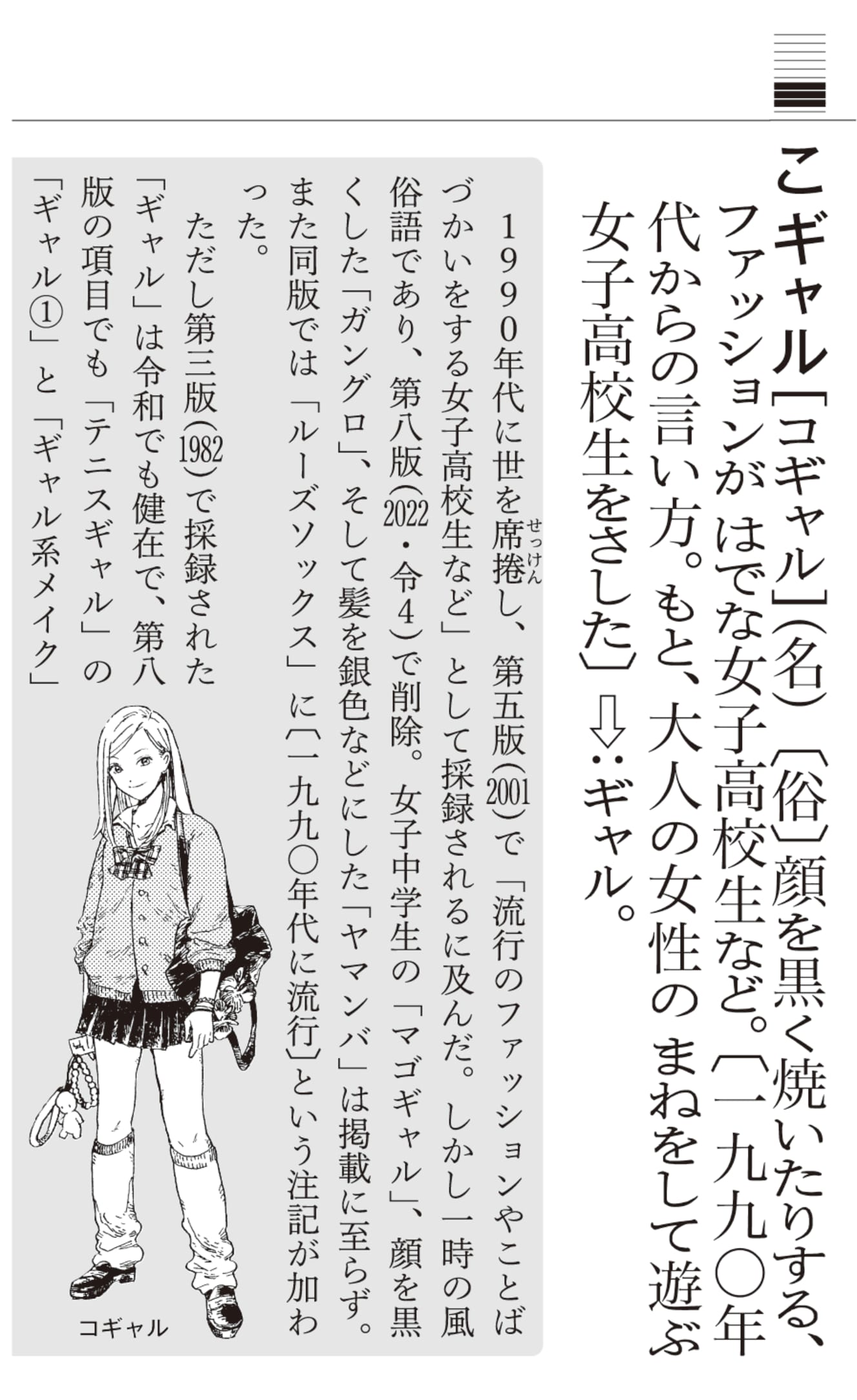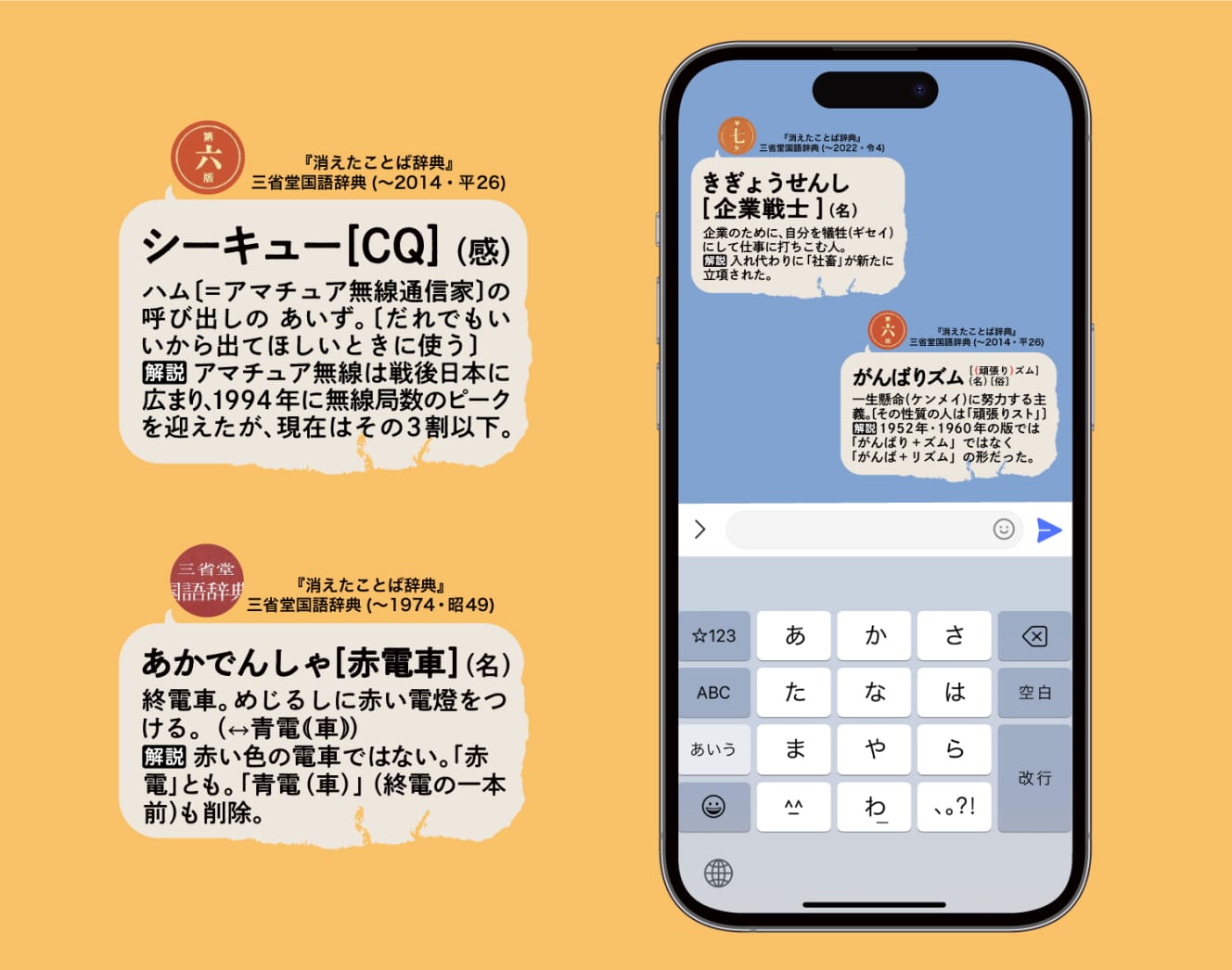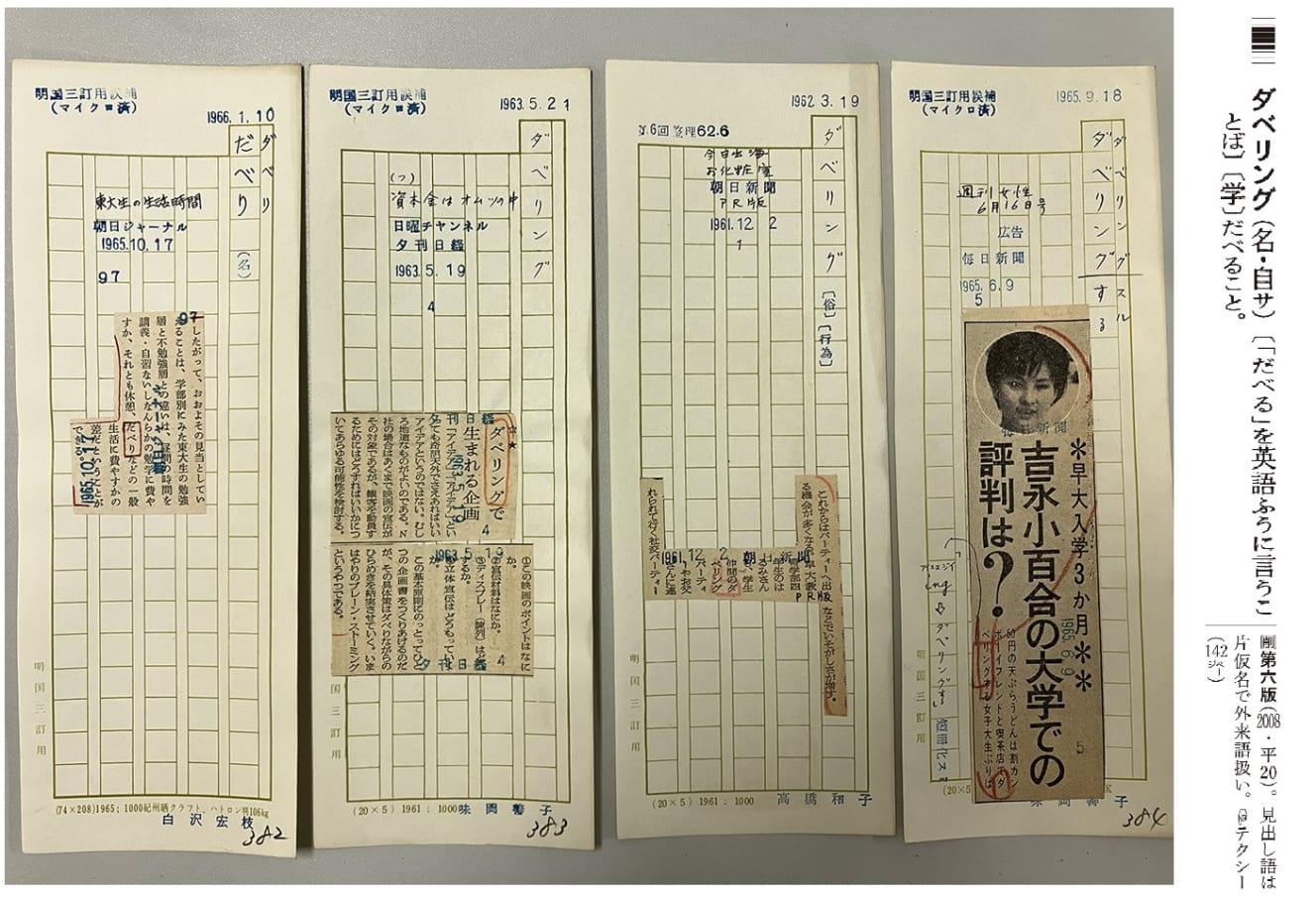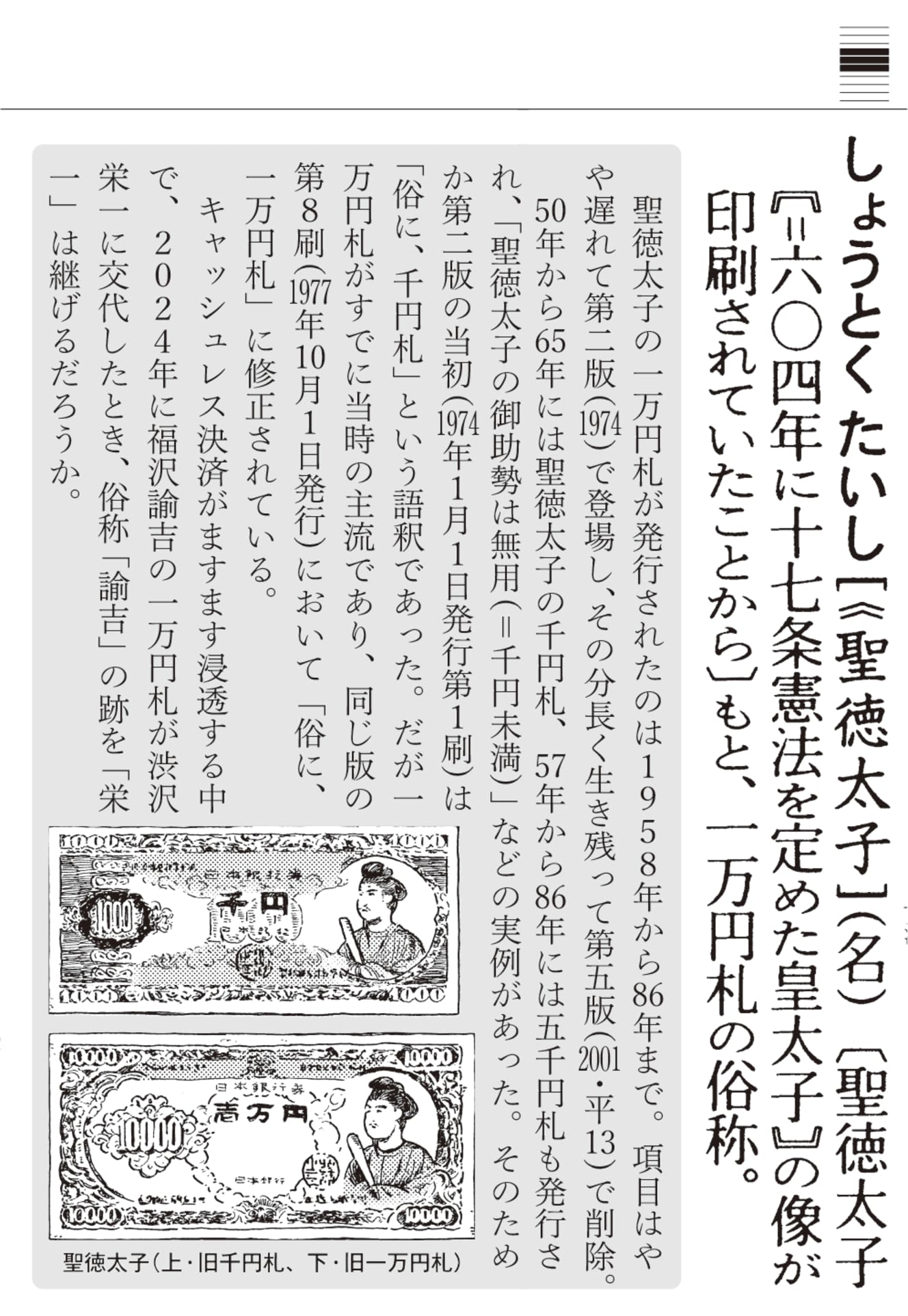Kogyal, Shotoku Taishi, Red Phone, Tsunagara-zoku… “A Dictionary of Words Deleted from Dictionaries” was born.
A commenter said, “I’d like to see a book with all the words that have disappeared…”
When the eighth edition of the Sanseido Japanese Dictionary was released at the end of 2009, the first fully revised edition in eight years, the deletion of words such as “MD,” “stu” and “kogyaru,” which are no longer in common use, became a hot topic.
But now, a fearless dictionary has appeared that collects only such “disappeared words”. The name of the dictionary is “Sanseido Kokugo Jiten Kara Kareta Kotoba Jiten (Dictionary of Missing Words from the Sanseido Japanese Dictionary).
This dictionary carefully selected 1,000 entries from those deleted in the nine revisions made over the past 80 years, from the Meikai Kokugo Jiten (published in 1943), the predecessor of the Sanseido Kokugo Jiten, to the 8th edition of the Sanseido Kokugo Jiten, and arranged them in Japanese syllabary order, enlarging the pages as they were at the time.
It took about a year to produce this mind-boggling volume, and it was the work of two people, Yukinori Mibo (“Mibo”), a “dictionary maniac” and reviewer, and Kentaro Okugawa (“Okugawa”) of Sanseido’s Dictionary Publishing Department. We asked them how this book was created.
Mr. Mibow said, “The impetus for this book came from the many requests we received on social networking sites and directly from the editorial department for a book containing only missing words, and a proposal from the sales and marketing department for a book.
For many people, the first thing that comes as a surprise is that we have removed words from the dictionary. There are words that I am still attached to, and even those of my generation who know nothing about them become interested when they hear that a word has been deleted, saying, ‘I didn’t know such a word existed.
When it is introduced on TV that these words are missing from the latest Sanseido Dictionary of the Japanese Language, they say, ‘I would rather read the ones that have been deleted. The company decided to give it a try because there was unexpected demand for the deleted words, which we had previously thought was a non-business area,” said Okukawa.

Mr. Mibo adds that the “missing words” attracted attention in large part because of the nature of the Sanseido Dictionary of the Japanese Language.
Compared to other dictionaries, the Sanseido Dictionary of the Japanese Language is very closely connected to the contemporary world and places importance on words in use today.
In order to fit new words into a small dictionary, old words inevitably have to be kicked out, which means that the dictionary has a very intense metabolism.”
A “deep connection” that led to Mr. Mibo’s selection as an editor
In fact, Mr. Mibo was chosen as the editor because he is a “dictionary maniac” who is well versed in the characteristics of each dictionary and can analyze and explain why words disappear from dictionaries.
My grandfather, Goki Mibo, founded the predecessor of the “Meikai Kokugo Jiten” (Meiwa Kokugo Jiten) and created most of the dictionaries up to the fourth edition of the “Sanseido Kokugo Jiten,” so I have a very strong personal attachment to this dictionary.
Besides, my family has preserved not only the different editions of the past “Sanseido Japanese Dictionary” but also the different printings, and in some cases, we can tell from the preserved materials that some corrections were made in the middle of the edition,” said Mr. Mibo.
When a new edition is issued, the contents are revised significantly, but usually few corrections are made during the reprinting process. In the past, however, there were times when the explanation was slightly revised in different printings,
For example, the section called “Inder Paper. At first, the explanation was that it was soft and thin, but from the 37th printing, there was a minor change where the explanation ‘soft and thin’ disappeared.
We found this out because, in the process of creating the book manuscript, we had a disagreement with the proofreader when verifying whether the actual paper and the explanation matched. We had to take up the item “india paper” because the item itself had disappeared, and we also found out that there were minor changes even with the difference in printing,” said Mr. Mibo.
Mr. Okukawa planned and edited the entire book, and the selection of entries for the nine revisions was divided into the first half and the second half.

Was there ever a time when a large number of words disappeared due to revisions?
There were times when a large number of words were lost in the revision process. For example, military terminology during the war and terms that appeared in the lives of the citizens disappeared after the war because they were no longer needed in the modern language.
Also, I think it is possible that many of the very core vocabulary terms included in the predecessor Meikai Japanese Dictionary are likely to remain, whereas the modern words that were added later and increased in number are likely to change. Other words, like those related to new technology or media, may be short-lived as items,” said Mibo.
Things that have fallen out of use as words, but the concept is still alive and well.
One example is “thermal storehouse. This is the opposite of a refrigerator, and although a thermal warehouse for keeping heat high is listed only in the second edition, it has disappeared as a word not used in normal life. Another example is the latte cassette (a combined radio, TV, and cassette deck that was sold from the late ’70s to the early ’80s) and MD, which disappeared with the times, although the tape recorder remains.
The adverb “tokkawa,” which describes a rush, disappeared in the second edition, but it has a cute character, too. Words themselves rise and fall, and even if they disappear, it does not mean that MD, for example, has disappeared, and there are quite a few concepts themselves that are universal and can be used even in different times.
This book was an opportunity for me to look for such words that are still valid today. It would be fun to use this book as an opportunity to search for such words that are still used today, or to revive the use of them,” said Mr. Mibo.
The number of “1,000 words” in the book soon exceeded the planned number, and it was a difficult task to cut them down, but Mr. Mibo explains the criteria for selecting the words.
One word that best describes the state of the world at the time, for example, bus girl, air boy, or auto tricycle, and that you can smell just by listening to it. Or words that have fallen out of use as words, but the concept is still alive and kicking.
My favorite word is “tsukisu-teki,” which I think is a perfect word for today’s age when evidence and facts are valued, but it disappeared at a very early stage. I also mix in items that are simply interesting to read or have a cute way of writing annotations.
Scanning the paper at the time + footnotes… “A storm of research” and repetition of time-consuming work
The paper is divided into three columns, with the middle column containing an enlarged version of the original edition that was published just before the disappearance of the magazine. This is an endless and time-consuming process.
The sixth and later editions barely had any data left, so we extracted them from there, but for the fifth and earlier editions, we had a specialist scanner cut and scan the actual pages. The fifth edition was printed in two colors, so when we converted it to black and white, we had to gray out the colored parts and do other very detailed work,” said Okukawa.
Each word has a gauge indicating the edition in which it appeared and the edition in which it disappeared, so that the reader can tell at a glance which edition it appeared in and which edition it disappeared from. In a sense, it is like an indicator of the life span of a word,” says Mr. Mibo, “but there are words that have disappeared, returned for a time, and then disappeared again.
Some of the words that have disappeared from the Meiyo Kai Japanese Dictionary are written in old characters because they were printed on old wartime typesetting paper.
Mr. Okukawa and I write supplementary footnotes to explain briefly what the word means and in what situations it was used, assuming that people of today would be interested in reading it, but the dictionary is very brief, so unless you were alive at the time, you may not have a clear idea of what it means. But dictionaries are very short, so unless you were alive at the time, you may not have a clear idea of what they mean.
For words that were too old to be understood, it was necessary to start by looking them up, which led to a “storm of research. Specifically, he looked up words in the “Japan Knowledge” database of dictionaries and lexicons, the “Dictionary of the Japanese Language,” the “Dictionary of Japanese Slang,” and the “Digital Collection of the National Diet Library,” as well as other sources, and also consulted raw materials.
He said, “I will visit the reference room to check the 140-odd thousand strip-type usage cards that Gouki Mibo had collected and that Sanseido has stored in its archives. The words in the Sanseido Japanese dictionary are closely related to our daily lives, so we use the example cards to confirm how they were actually used and why they were included in the dictionary,” said Mr. Mibo.

Why “Shotoku Taishi” disappeared in 2001
What is interesting, for example, is that the term “Shotoku Taishi” disappeared in ’01. This is not the usual dictionary-style “King Umayato” or “enactment of the Seventeen-Article Constitution or the Crown Twelve Ranks,” nor is it a story about how he disappeared from textbooks because he “actually did not exist.

The Sanseido Dictionary of the Japanese Language only discusses Shotoku Taishi as a “10,000-yen bill” used in daily life. This is because, as a term actually used in daily life, ‘Shotoku Taishi’ will no longer be said when the 10,000-yen bill is replaced by Fukuzawa Yukichi,” said Mibo.
As this example shows, there are many words that the younger generation does not have a clear idea of how to use, even if they think they know the words themselves. Familiar and attached words and their usage differ from generation to generation. It would be good to look into the background of the “vanished words” of each era, and it would also be fun to look at them together with family members or other people of different generations, or to quiz each other.
Interview and text by: Wakako Takou
Born in 1973. After working for a publishing company and an advertising production company, became a freelance writer. In addition to interviewing actors for weekly and monthly magazines, she writes columns on drama for a variety of media. His main publications include "All Important Things Are Taught by Morning Drama" (Ota Publishing), "KinKi Kids Owarinaki Michi" and "Hey! Say! JUMP 9 no Tobira ga Open Tokimono" (both published by Earls Publishing).